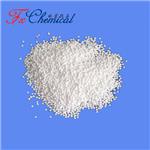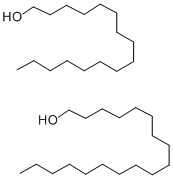Cetearyl Alcohol: Versatile Compound in Cosmetics Industry
Jan 4,2024
General Description
Cetearyl alcohol is a versatile compound commonly used in the cosmetics industry. It serves as a thickening agent, stabilizer, and emulsifier in various personal care products. It has a solid, white to off-white granular form with a mild wax-like odor. Cetearyl alcohol is insoluble in water but soluble in ethanol and light petroleum. It is synthesized from fatty acids derived from natural sources like coconut oil or palm kernel oil. This compound is considered non-toxic but can cause mild irritation to the eyes and skin. Therefore, proper safety precautions, such as using protective equipment, should be taken when handling it.

Figure 1. Cetearyl alcohol
Properties and Synthesis
Cetearyl alcohol is an organic compound commonly used in the cosmetics industry as a thickening agent, stabilizer, and emulsifier. It is a solid, white to off-white granular material with a mild wax-like odor and a melting point range of 51-53°C. Cetearyl alcohol is practically insoluble in water but soluble in ethanol (96%) and light petroleum. When melted, it can mix with fatty oils, liquid paraffin, and melted lanolin. The main chemical constituents of cetearyl alcohol are cetyl and stearyl alcohols, which have 16 and 18 carbon atoms in their respective chains. These alkyl chains provide the compound with surfactant properties that enable it to mix oil and water-based ingredients in personal care products. Cetearyl alcohol also has a low acidity coefficient (pKa) of 15.76[at 20℃]. Cetearyl alcohol is synthesized by the reduction of fatty acids derived from natural sources such as coconut oil or palm kernel oil. It is classified as an organic intermediate, and its production is mainly utilized in personal care products, cosmetics, and pharmaceuticals. In conclusion, cetearyl alcohol is a versatile compound with unique properties that make it a popular ingredient in various personal care products. Its solubility, melting point, and surfactant properties make it an excellent emulsifier and thickening agent in cosmetic formulations. 1
Applications in Cosmetics Industry
Cetearyl alcohol, also known as alcohols C16-18, finds a wide range of applications in various industries. In the cosmetics industry, it serves as an emulsion stabilizer, controlling viscosity, and providing emollient properties. It is also used as an emulsifier, aiding in the blending of oil and water-based ingredients, and as an opacifier, giving products an opaque appearance. According to the Environmental Protection Agency (EPA), Cetearyl alcohol is employed as a surfactant, thickening agent, and pigment in consumer products. It is commonly found in personal care items and household products, such as cleaning agents and inside-the-home products. In terms of production volume in the United States, Cetearyl alcohol falls within the range of 1,000,000 to <10,000,000 pounds annually for the years 2016 to 2019. It is manufactured in various sectors, including basic organic chemical manufacturing, chemical product and preparation manufacturing, plastics material and resin manufacturing, printing ink manufacturing, synthetic dye and pigment manufacturing, and wholesale and retail trade. To summarize, Cetearyl alcohol is extensively used in the cosmetics industry as an emulsion stabilizer, viscosity controller, emollient, emulsifier, and opacifier. It also finds applications as a surfactant, thickening agent, and pigment in consumer products and household items. 2
Safety Considerations
Cetearyl alcohol is a non-toxic material that can cause mild irritation upon contact with eyes or prolonged skin exposure. It has been classified as an irritant, with Skin Irrit. 2 and Eye Irrit. 2 categories. In case of eye exposure, flush with water and seek medical attention if irritation persists. For skin contact, wipe off and wash with soap and water. Personal protective equipment such as goggles or a face shield and rubber gloves are recommended when handling this substance. Cetearyl alcohol is insoluble in water and does not react with air or water. It belongs to the group of alcohols and polyols, and should be kept away from acetyl bromide, concentrated sulfuric acid, and strong hydrogen peroxide as they can cause explosions. Mixtures of ethyl alcohol with concentrated hydrogen peroxide can form powerful explosives. Therefore, caution must be taken when handling this substance and it is important to follow safety procedures to avoid any potential hazards. 3
Reference
1. Cetearyl alcohol. National Center for Biotechnology Information, 2023, PubChem Compound Summary for CID 62238.
2. Alcohols, C16-18. EPA Chemicals under the TSCA.
3. TALLOW FATTY ALCOHOL. CAMEO Chemicals, 9103.
- Related articles
- Related Qustion
- Cetearyl Alcohol: Overview, Benefits in Skincare and Origin May 11, 2024
Cetearyl alcohol, derived from plants, serves as a versatile ingredient in skincare, providing moisturizing, emulsifying, and stabilizing benefits.
- The Side Effects of Cetearyl Alcohol Nov 22, 2022
The passage introduces the side effects of Cetearyl alcohol.
D-mannose, a monosaccharide found in animal and vertebrate, is absorbed into the bloodstream and reaches peak levels within 60-90 minutes with potential in preventing and treating UTIs.....
Jan 4,2024APIBis(4-hydroxyphenyl) sulfone is a white crystalline compound used in various industries. It is used as an intermediate and electroplating solvent and hazardous with reproductive toxicity.....
Jan 4,2024APICetearyl alcohol
67762-27-0You may like
Cetearyl alcohol manufacturers
- Cetearyl alcohol
-

- $0.00 / 1kg
- 2024-05-16
- CAS:67762-27-0
- Min. Order: 1kg
- Purity: 100.4%
- Supply Ability: 20TM
- Cetostearyl Alcohol
-

- $0.00 / 1KG
- 2024-05-15
- CAS:67762-27-0
- Min. Order: 1KG
- Purity: 99%
- Supply Ability: 1 ton
- Cetostearyl Alcohol
-

- $0.00 / 1KG
- 2024-05-15
- CAS:67762-27-0
- Min. Order: 1KG
- Purity: 99%
- Supply Ability: 1 ton




